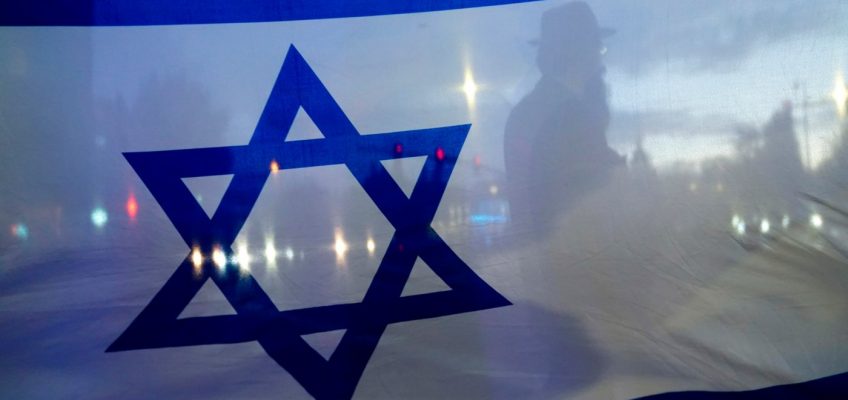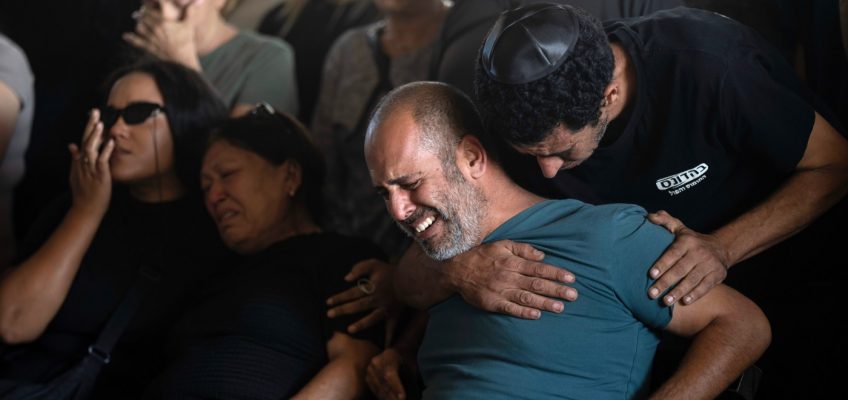If you care about Israel, you should be more worried than any time since 1967. Back then, Israel defeated the armies of three Arab states — Egypt, Syria and Jordan — in what became known as the Six-Day War. Today, if you look closely, you’ll see that Israel is now fighting the Six-Front War.
This war is being fought by and through nonstate actors, nation-states, social networks, ideological movements, West Bank communities and Israeli political factions, and it is the most complex war that I’ve ever covered. But one thing is crystal clear to me: Israel cannot win this six-front war alone. It can win only if Israel — and the United States — can assemble a global alliance.
Unfortunately, Israel today has a prime minister, Benjamin Netanyahu, and a ruling coalition that will not and cannot produce the keystone needed to sustain such a global alliance. That keystone is to declare an end to the expansion of Israeli settlements in the West Bank and the overhaul of Israel’s relations with the Palestinian Authority so that it becomes a credible, legitimate Palestinian partner than can govern a post-Hamas Gaza Strip and forge a broader two-state solution including the West Bank.
If Israel is asking its best allies to help the Jewish state seek justice in Gaza while also asking them to look the other way as Israel builds a settlement kingdom in the West Bank with the expressed goal of annexation, that is strategically and morally incoherent.
It won’t work. Israel will not be able to generate the time, the financial assistance, the legitimacy, the Palestinian partner or the global allies it needs to win this six-front war.
And all six fronts are now hiding in plain sight.
First front
First, Israel is fighting a full-scale war against Hamas in and around Gaza, in which, we can now see, Hamas still has so much residual capacity that it was able to launch a seaborne attack on Israel on Tuesday and on Wednesday fired long-range rockets toward Israel’s southern port city of Eilat and northern port city of Haifa.
It is terrifying to see how many resources Hamas diverted to build weapons rather than Gaza’s human capital — and how effectively it hid that from Israel and the world. Indeed, it is hard not to notice the contrast between Gaza’s evident human poverty and the wealth of weaponry Hamas has built and deployed.
Hamas’ dream has long been the unification of the fronts surrounding Israel, regionally and globally. Israel’s strategy has always been to act in ways to prevent that — until this Netanyahu coalition of ultra-Orthodox and Jewish supremacists came to power in December and began behaving in ways that actually helped foster the unification of the anti-Israel fronts.
How so? The Jewish supremacists in Netanyahu’s Cabinet immediately began to challenge the status quo on the Temple Mount in Jerusalem, which is revered by Muslims as the Noble Sanctuary and where one of Islam’s holiest sites, Al-Aqsa Mosque, stands. The Netanyahu government began taking steps to impose much harsher conditions on Palestinians from the West Bank and Gaza held in Israeli jails. And it laid plans for a huge expansion of Israeli settlements in the West Bank to prevent a contiguous Palestinian state from ever coming into being there. This is the first Israeli government ever to make annexation of the West Bank a stated objective in its coalition agreement.
On top of all of this, the United States appeared to be getting close to forging a deal for Saudi Arabia to normalize diplomatic and commercial relations with Israel — which would have been the crowning achievement of Netanyahu’s effort to prove that Israel could have normal relations with Arab and Muslim states and not have to give one inch to the Palestinians.
Second
Which leads to the second front: Israel against Iran and its other proxies.
That is, Hezbollah in Lebanon and Syria, Islamist militias in Syria and Iraq and the Houthi militia in Yemen.
All of them in recent days have launched drones and rockets toward Israel or at U.S. forces in Iraq and Syria. I believe that Iran, like Hamas, saw the U.S.-Israel effort to normalize relations between Israel and Arab-Muslim states as a strategic threat that would have left Iran and its proxies isolated in the region. At the same time, I believe Hezbollah came to realize that if Israel obliterated Hamas, as it declared it would, Hezbollah would be next. It would also be much weaker without Hamas draining energy and focus from Israel’s military. Therefore, Hezbollah decided that, at a minimum, it needed to open a low-grade second front against Israel.
As a result, Israel has been forced to evacuate some 130,000 civilians from its northern border along with the tens of thousands of Israelis evacuated from the southwestern border with Gaza. This whole displacement puts a huge stress on housing and the Israeli treasury.
Third
The third front is the universe of social networks and other digital narratives about who is good and who is evil.
When the world gets this interdependent, when — thanks to smartphones and social networks — nothing is hidden and we can hear each other whisper, the dominant narrative has real strategic value. That social media was so easily manipulated by Hamas that the episode of a misfired Palestinian missile hitting a Gaza hospital was initially blamed on Israel is deeply disturbing, because these narratives shape the decisions of governments and politicians and the relationship between chief executives and their employees.
Fourth
The fourth front is the intellectual/philosophical struggle between the international progressive movement and Israel.
I believe that some elements of that progressive movement, which I realize is big and diverse, have lost their moral bearings on this issue. For instance, we’ve seen numerous demonstrations on American college campuses that essentially blame Israel for the barbaric Hamas invasion, arguing that Hamas is engaged in a legitimate “anti-colonial struggle.” These progressive demonstrators seem to believe that all of Israel is a colonial enterprise — not just the West Bank settlements — and therefore the Jewish people do not have the right either to self-determination or self-defense in their ancestral homeland, whether it’s within post-1967 borders or pre-1967 ones.
And for an intellectual community seemingly concerned about nations occupying other nations and denying their right to self-rule, you don’t see a lot of progressive college campus demonstrations against the biggest oppressing power in the Middle East today: Iran.
Besides crushing its own women seeking greater freedom of thought and dress, Iran is effectively controlling four Arab states — Lebanon, Syria, Yemen and Iraq — through its proxies. Lebanon, a country I know well, has not been able to elect a new president for a year in large part because Iran refuses to allow the Lebanese to have any president who will not always bend to Tehran’s wishes and interests. Unfortunately, independent Lebanese are powerless to remove Iran’s grip over their parliament and government, exercised largely through the barrel of Hezbollah guns. Middle East Eye reported that back in 2014 Ali Reza Zakani, a Tehran city representative in the Iranian parliament, was boasting about how Iran now rules in four Arab capitals: Baghdad, Damascus, Beirut and Sanaa, Yemen.
To reduce this incredibly complex struggle of two peoples for the same land to a colonial war is to commit intellectual fraud. Or as Israeli writer Yossi Klein Halevi put it in The Times of Israel on Wednesday: “To blame the occupation and its consequences wholly on Israel is to dismiss the history of Israeli peace offers and Palestinian rejection. To label Israel as one more colonialist creation is to distort the unique story of the homecoming of an uprooted people, a majority of whom were refugees from destroyed Jewish communities in the Middle East.”
But here’s what’s also intellectually corrupt: buying into the Israeli right-wing settler narrative, now being spread far and wide inside Israel, that Hamas violence is so savage it clearly has nothing to do with anything settlers have done — so more settlements are just fine.
My view: This is a territorial dispute between two people claiming the same land which needs to be divided as equitably as possible. Such a compromise is the cornerstone for any success against Hamas. So, if you are for a two-state solution, you are my friend and if you are against a two-state solution, you are not my friend.
Fifth
The fifth front is inside Israel and the occupied territories.
In the West Bank, right-wing Jewish settlers are attacking Palestinians, while disrupting the efforts of Israel’s military to keep a lid on it in collaboration with the security forces of the Palestinian Authority, led by Mahmoud Abbas. We must remember that the authority has recognized Israel’s right to exist as part of the Oslo accords. It would be terrible if that front explodes into a confrontation between the authority and Israel, because then there would be scant hope for ever enlisting the authority’s help in governing Gaza.
But there will also be no hope for that if Palestinians in the West Bank and around the world don’t insist on building a more effective, non-corrupt Palestinian Authority. That is long past due — and it is not just Israel’s fault that it has not happened. Palestinians have agency, too.
Sixth
The sixth front is inside Israel itself, mostly between its Jewish citizens.
That front has been papered over for the moment, but it lurks just beneath the surface. It is the clash driven by Netanyahu’s enduring political strategy at home: divide and rule. He has built his whole political career on pitting factions of Israeli society against one another, eroding the kind of societal unity that is essential to win the war.
His government took that strategy to an extreme after it came into office in December and immediately moved to strip the Israeli Supreme Court of its powers to check decisions of the executive and legislative branches. In the process he turned tens of thousands of Israelis out every Saturday to protect their democracy and prompted air force pilots and other elite war-fighters to suspend their reserve duty, saying they would not serve a country heading toward dictatorship. It divided and distracted Israel and its military at exactly the wrong time — not that there was ever a good time.
How do you win a six-front war?
I repeat: only with a coalition of people and nations who believe in democratic values and the right of self-determination for all people. Until and unless Israel generates a government that can generate that coalition, it will not have the time, the resources, the Palestinian partner and the legitimacy it needs to take down Hamas in Gaza. It will be fighting mostly alongside the United States as its only true and sustainable ally.
And a lot of the strength of that alliance today rests on Joe Biden and the fact that he brings to this crisis a set of core, gut principles about America’s role in the world, right versus wrong, democracy versus autocracy. Another president with those instincts may not come along again anytime soon.
In other words, Biden has created diplomatic working capital — that comes with a time limit — for both Israelis and the Palestinian Authority. They must both use it wisely.
Thomas Friedman, who was born in Minneapolis and grew up in St. Louis Park, writes a column for the New York Times.




